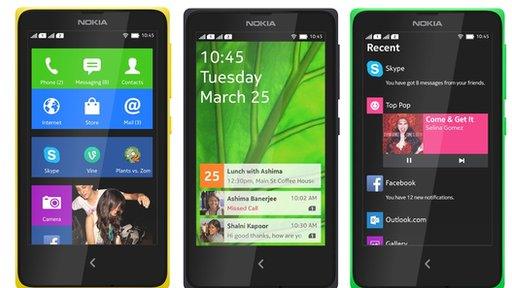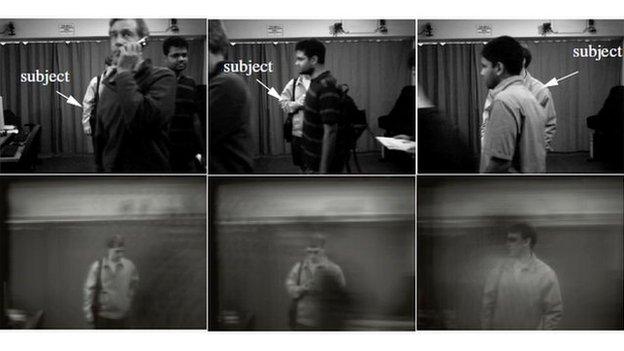Microsoft phones get flash trick for low light snaps
- Published
Testing out Lumia's flash trick
Microsoft's Lumia smartphones are getting a new feature designed to improve the quality of photos taken in low-light settings.
The facility automatically takes two photos in quick succession, one with a flash and one without.
Software then merges the two shots into a single image for which the user can adjust the amount of illumination via an on-screen slider bar.
Photo innovations are at the heart of the division's marketing efforts.
Microsoft spent much of a press conference at the Ifa tech show in Berlin detailing imaging improvements coming to both its new handsets and older models via a forthcoming software update dubbed Lumia Denim.
Marketing executive Chris Weber repeatedly claimed at the event that the company's top-end handsets outperformed Apple and Samsung's models.

Microsoft demonstrated how the dynamic flash function could be used to edit photos
But company watchers noted that this tactic had had limited success in the past when the unit was owned by Finland's Nokia.
"The track record isn't encouraging - Nokia put lots of money into investing in this area on R&D [research and development], and from a technical point of view they established a clear lead with the Lumia 1020 14 months ago," said John Delaney, head of research firm IDC's European mobility team.
"Since then, the Lumia devices released, in my opinion, have added superior performance both in terms of image capture and processing.
"Having said that. their market share is still very small."
The Windows Phone platform as a whole accounted for just 2.5% of global smartphone shipments in the April-to-June quarter, according to IDC, external, with Nokia-branded devices accounting for the majority of stock.
Another expert suggested part of the problem was ensuring customers understood what Lumia offered.
"If it takes quite a lot of time to explain and demonstrate these features at a press conference, what do you think it will take to ensure they are communicated at the retail level?" asked Jasdeep Badyal, from the tech consultancy CCS Insight.
"Lumia does come out ahead of Samsung and Apple [in imaging], but how much do consumers know that?
"It's a roadblock in that sense, and often the ultimate purchase decision comes down to the brand recognition and loyalty that Apple and Samsung have built. It will take a very very big effort to change that."
Dynamic flash
The idea of combining multiple exposures of an image to create a superior shot has already been popularised by the high dynamic range (HDR) function offered by many smartphones.
But the idea of combining images with and without flash can be traced back to a patent filed by Microsoft in 2004., external
In it, researchers noted that combining information from the two pictures could avoid the "jarring", "harsh" look caused by a flash, while minimising the amount of visible "noise" - a common problem found in no-flash low-light photos.

Microsoft compared the quality of its latest Lumia to that of Apple's iPhone 5S
Kristina Bjorknas, senior experience marketing manager at Microsoft, suggested that Lumia owners could now leave decisions about lighting until days after pictures had been taken.
"We take away the need to make a decision in advance," she said.
"This dynamic flash is a completely unique Lumia imaging experience, [I'm] super-proud of it, and we're bringing this experience to many devices."
Other imaging upgrades announced at the event included:
The ability to take multiple images with only a 42 millisecond gap between each shot. The firm said that up to 12 images could be taken in the time it takes to blink
An option to extract 8.3 megapixel stills from the 4K ultra-high definition video captured by its high-end models
An app that allows the user to whiten their teeth, make themself look slimmer and make other cosmetic changes to selfie snaps

Microsoft said its Lumia 735 model had been designed with selfies in mind
The firm is also promoting its new Lumia 735 handset as the "best for selfies".
The model has a five megapixel front camera, which is higher resolution than many rivals but still outclassed in terms of specs by the 8MP component featured in new models from HTC and Huawei.
However, Nokia suggests that the wide-angle nature of its lens should help it both squeeze more people into a single shot and keep them all sharp "like no other phone out there".
- Published11 August 2014

- Published17 July 2014

- Published11 July 2013
